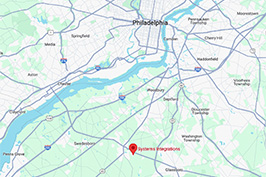The Hidden Costs of Unlicensed Security Contractors in New Jersey
When it comes to securing your New Jersey business, the lowest bid isn’t always the best deal. In fact, hiring an unlicensed security contractor can cost you far more than you’ll ever save—and put your business at serious risk.
As a licensed security integrator with over 20 years of experience serving businesses across New Jersey, Pennsylvania, and Delaware, I’ve seen firsthand the expensive consequences when businesses cut corners on contractor selection.
New Jersey Requires Licensing for Good Reason
New Jersey mandates licensing for security system installation and service for critical reasons: public safety, system reliability, and professional accountability. When you hire an unlicensed contractor, you’re not just breaking state law—you’re exposing your business to significant financial and operational risks.
Verify any contractor’s license through New Jersey’s official state licensing system before signing any contract.
The Real Costs of Going Unlicensed
1. Insurance Nightmares and Liability Exposure
The Hidden Cost: Your business insurance may not cover damages or theft if your security system was installed by an unlicensed contractor.
Real Example: A Camden County business owner discovered their insurance claim was denied after a break-in because their security system was installed by an unlicensed contractor. The insurance company argued the system wasn’t professionally installed according to industry standards.
Financial Impact: $45,000 in uncovered theft losses plus legal fees to dispute the insurance denial.
2. System Failures When You Need Protection Most
The Hidden Cost: Unlicensed installers often lack proper training on system configuration, power backup, and network integration.
Real Example: During a recent storm in Gloucester County, a manufacturer’s security system failed completely because the unlicensed installer hadn’t properly configured the backup power system or surge protection.
Financial Impact: Complete system replacement ($18,000) plus lost productivity during the security gap.
3. Compliance Violations and Regulatory Penalties
The Hidden Cost: Many industries require professionally installed, compliant security systems for regulatory compliance.
Real Example: A healthcare facility in Burlington County faced state regulatory penalties because their unlicensed contractor installed cameras that violated HIPAA privacy requirements.
Financial Impact: $25,000 in regulatory fines plus mandatory system redesign and reinstallation.
4. No Professional Support When Problems Arise
The Hidden Cost: Unlicensed contractors often disappear when systems need service, leaving you with no technical support or warranty coverage.
Real Example: A Salem County business couldn’t access their own building when their card access system failed because the unlicensed installer had moved out of state and left no documentation or support contacts.
Financial Impact: Emergency locksmith services ($800) plus complete system replacement by a licensed contractor ($12,000).
5. Cybersecurity Vulnerabilities
The Hidden Cost: Modern security systems connect to your network. Improper installation creates entry points for cyber attacks.
Real Example: An unlicensed contractor connected IP cameras directly to a company’s main network without proper segmentation, creating a pathway for hackers to access sensitive business data.
Financial Impact: Data breach response costs ($35,000) plus lost customer trust and business.
What Licensed Contractors Provide That Unlicensed Don’t
Professional Accountability
Licensed contractors are bonded, insured, and accountable to state regulatory bodies. We maintain $3,000,000 in coverage specifically for security and IT installations.
Ongoing Education and Certification
Licensed professionals complete continuing education requirements and maintain certifications on current technology. Our technicians are trained and certified on all equipment we install.
Code Compliance and Proper Installation
We understand local building codes, fire safety requirements, and industry standards that ensure your system works reliably and meets all regulatory requirements.
Professional Support and Warranties
Licensed contractors provide ongoing support, maintenance agreements, and warranty coverage. We offer emergency response within 4 hours and maintain detailed documentation for every installation.
Cybersecurity Expertise
Modern security requires understanding both physical and digital security. We maintain security industry cybersecurity certification to protect your systems from evolving threats.
The Smart Investment: Licensed Professional Installation
When you hire a licensed security contractor, you’re not just buying equipment installation—you’re investing in:
- Legal compliance that protects your business
- Insurance coverage that actually pays claims
- Professional support when you need it most
- System reliability that works during emergencies
- Cybersecurity protection for connected systems
- Regulatory compliance for your industry
- Long-term value through proper maintenance and upgrades
Red Flags: How to Spot Unlicensed Contractors
Watch out for contractors who:
- Can’t provide a current New Jersey license number
- Offer prices significantly below market rates
- Request full payment upfront
- Can’t provide proof of insurance
- Don’t offer written warranties
- Avoid discussing permits or inspections
- Can’t explain cybersecurity considerations
Verify Before You Hire
Always verify licensing through New Jersey’s official state system. A legitimate contractor will gladly provide their license number and encourage you to verify their credentials.
Ask for:
- Current license verification
- Proof of insurance coverage
- References from recent installations
- Written warranties and support agreements
- Detailed project documentation
Protect Your Investment
Your security system is too important to trust to unlicensed contractors. The short-term savings aren’t worth the long-term risks to your business, employees, and customers.
Ready to work with a licensed professional?
Systems Integrations holds active licenses in New Jersey, Pennsylvania, Delaware and Florida. We’ve been protecting businesses across South Jersey, Southeast Pennsylvania, and New Castle County, Delaware for over 20 years.
Contact us for a professional security assessment:
- Phone: (866) 417-3787
- Web: systems-integrations.com/contact
- Licensed in NJ, PA, DE, and FL
Don’t risk your business security on unlicensed contractors. Verify licensing, demand professional accountability, and protect your investment with properly licensed security integration services.


